Managerial Accounting: Essential Requirements and Methods
VerifiedAdded on 2023/01/11
|16
|5631
|74
AI Summary
This document provides an introduction to managerial accounting and its importance in decision making. It explains the essential requirements of different types of managerial accounting systems and discusses various methods used for management accounting reporting. The document also covers the advantages and disadvantages of planning tools used for budgetary control. Additionally, it includes a calculation of costs using appropriate techniques of cost analysis to prepare an income statement using marginal and absorption costs.
Contribute Materials
Your contribution can guide someone’s learning journey. Share your
documents today.
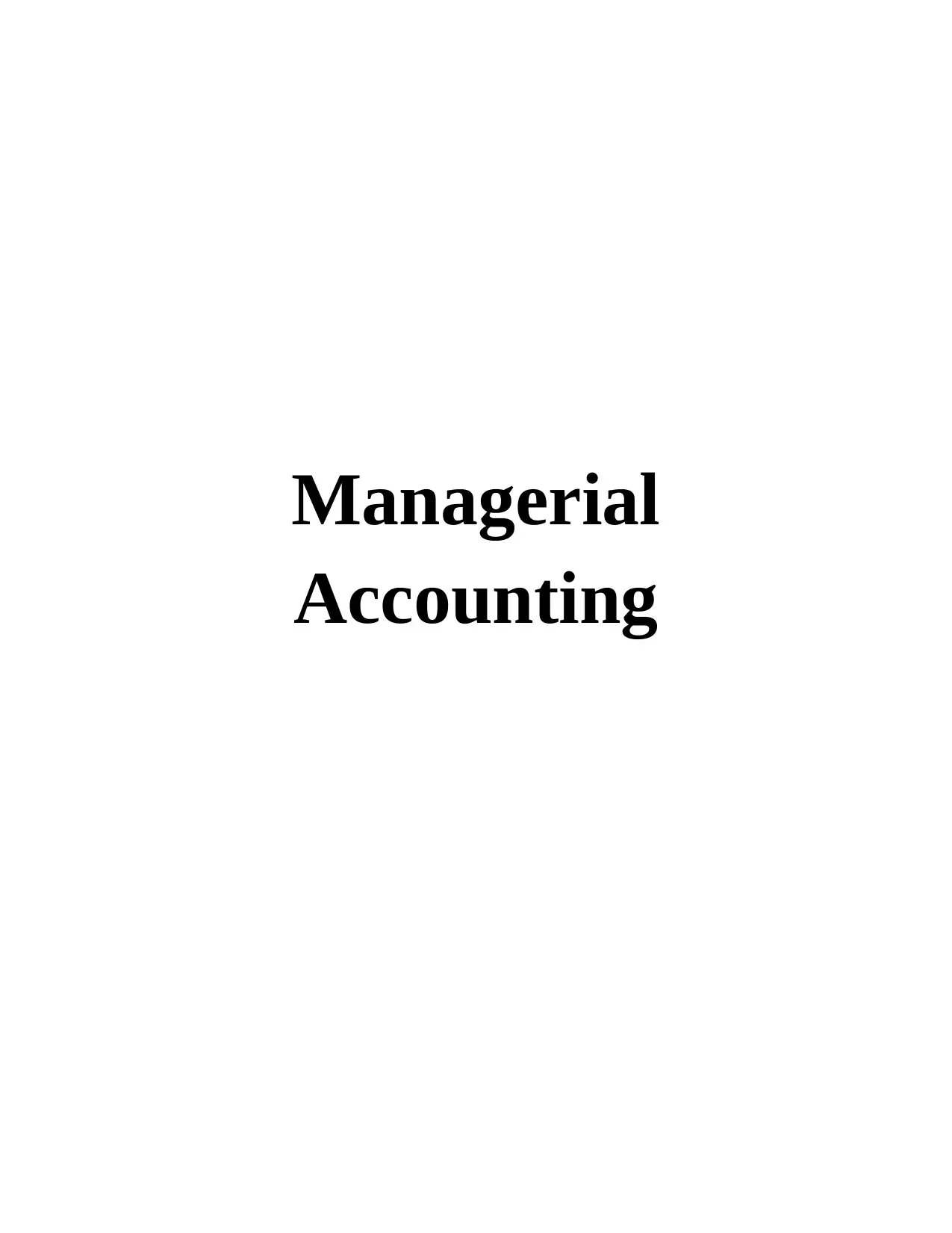
Managerial
Accounting
Accounting
Secure Best Marks with AI Grader
Need help grading? Try our AI Grader for instant feedback on your assignments.
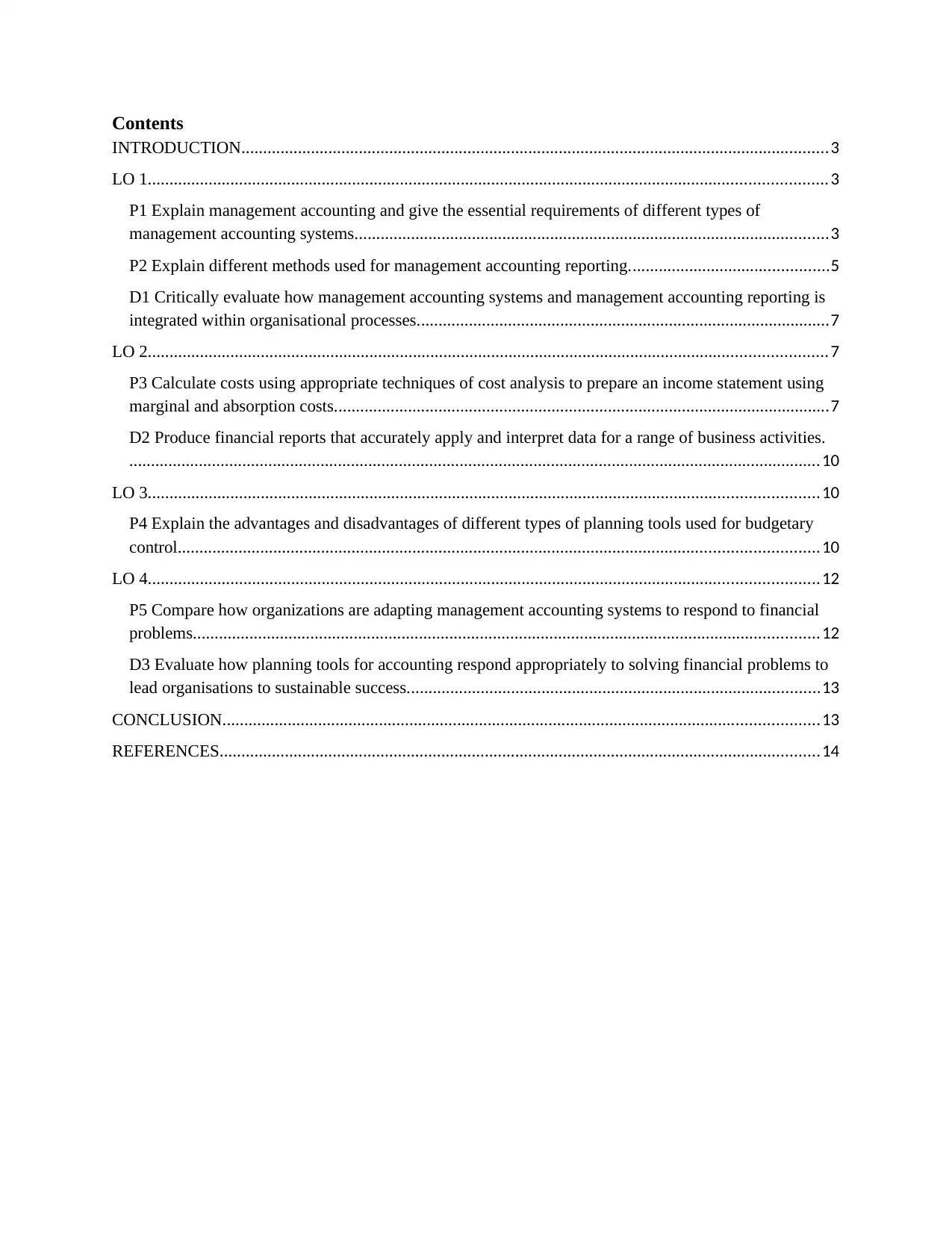
Contents
INTRODUCTION.......................................................................................................................................3
LO 1............................................................................................................................................................3
P1 Explain management accounting and give the essential requirements of different types of
management accounting systems.............................................................................................................3
P2 Explain different methods used for management accounting reporting..............................................5
D1 Critically evaluate how management accounting systems and management accounting reporting is
integrated within organisational processes...............................................................................................7
LO 2............................................................................................................................................................7
P3 Calculate costs using appropriate techniques of cost analysis to prepare an income statement using
marginal and absorption costs..................................................................................................................7
D2 Produce financial reports that accurately apply and interpret data for a range of business activities.
...............................................................................................................................................................10
LO 3..........................................................................................................................................................10
P4 Explain the advantages and disadvantages of different types of planning tools used for budgetary
control...................................................................................................................................................10
LO 4..........................................................................................................................................................12
P5 Compare how organizations are adapting management accounting systems to respond to financial
problems................................................................................................................................................12
D3 Evaluate how planning tools for accounting respond appropriately to solving financial problems to
lead organisations to sustainable success...............................................................................................13
CONCLUSION.........................................................................................................................................13
REFERENCES..........................................................................................................................................14
INTRODUCTION.......................................................................................................................................3
LO 1............................................................................................................................................................3
P1 Explain management accounting and give the essential requirements of different types of
management accounting systems.............................................................................................................3
P2 Explain different methods used for management accounting reporting..............................................5
D1 Critically evaluate how management accounting systems and management accounting reporting is
integrated within organisational processes...............................................................................................7
LO 2............................................................................................................................................................7
P3 Calculate costs using appropriate techniques of cost analysis to prepare an income statement using
marginal and absorption costs..................................................................................................................7
D2 Produce financial reports that accurately apply and interpret data for a range of business activities.
...............................................................................................................................................................10
LO 3..........................................................................................................................................................10
P4 Explain the advantages and disadvantages of different types of planning tools used for budgetary
control...................................................................................................................................................10
LO 4..........................................................................................................................................................12
P5 Compare how organizations are adapting management accounting systems to respond to financial
problems................................................................................................................................................12
D3 Evaluate how planning tools for accounting respond appropriately to solving financial problems to
lead organisations to sustainable success...............................................................................................13
CONCLUSION.........................................................................................................................................13
REFERENCES..........................................................................................................................................14
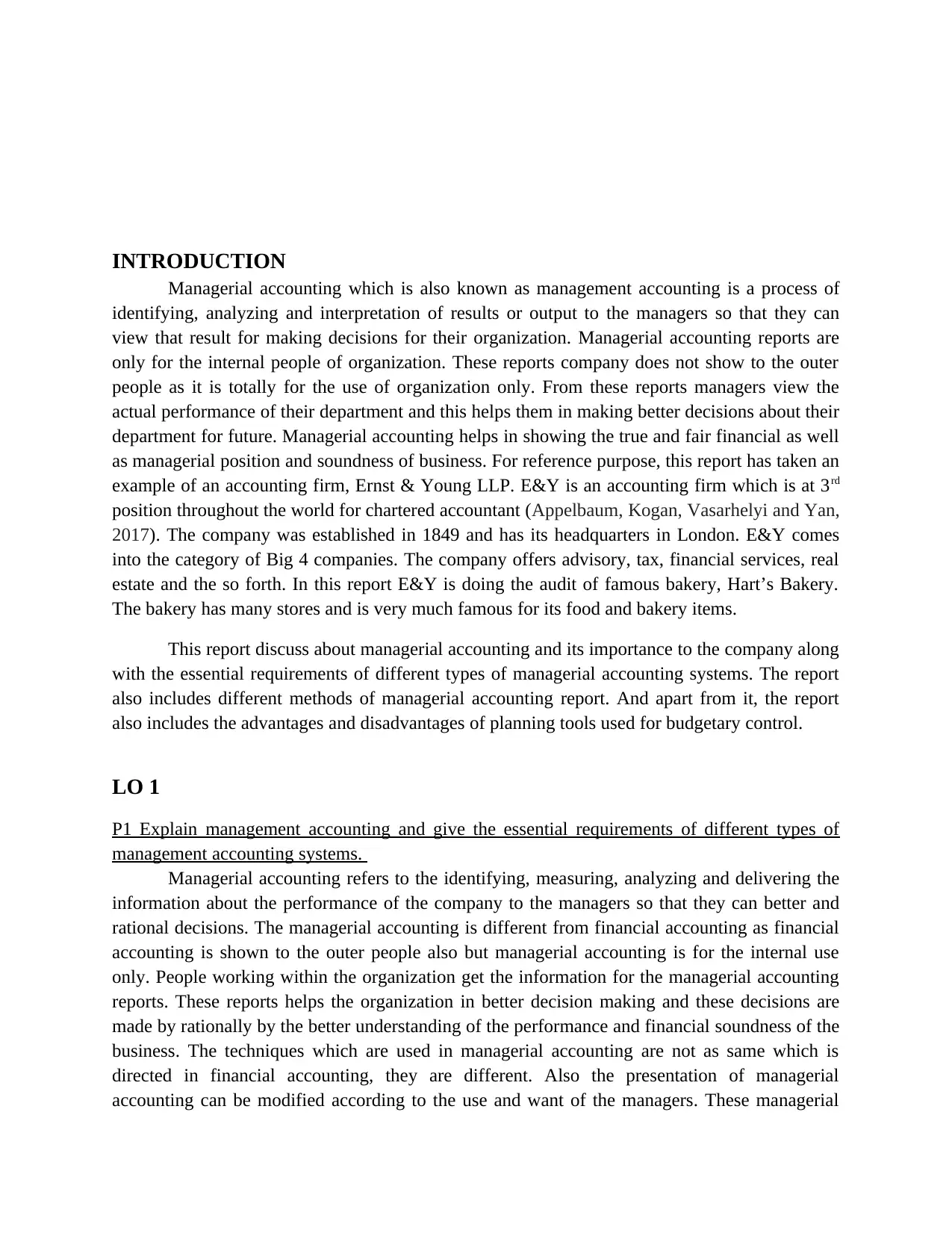
INTRODUCTION
Managerial accounting which is also known as management accounting is a process of
identifying, analyzing and interpretation of results or output to the managers so that they can
view that result for making decisions for their organization. Managerial accounting reports are
only for the internal people of organization. These reports company does not show to the outer
people as it is totally for the use of organization only. From these reports managers view the
actual performance of their department and this helps them in making better decisions about their
department for future. Managerial accounting helps in showing the true and fair financial as well
as managerial position and soundness of business. For reference purpose, this report has taken an
example of an accounting firm, Ernst & Young LLP. E&Y is an accounting firm which is at 3rd
position throughout the world for chartered accountant (Appelbaum, Kogan, Vasarhelyi and Yan,
2017). The company was established in 1849 and has its headquarters in London. E&Y comes
into the category of Big 4 companies. The company offers advisory, tax, financial services, real
estate and the so forth. In this report E&Y is doing the audit of famous bakery, Hart’s Bakery.
The bakery has many stores and is very much famous for its food and bakery items.
This report discuss about managerial accounting and its importance to the company along
with the essential requirements of different types of managerial accounting systems. The report
also includes different methods of managerial accounting report. And apart from it, the report
also includes the advantages and disadvantages of planning tools used for budgetary control.
LO 1
P1 Explain management accounting and give the essential requirements of different types of
management accounting systems.
Managerial accounting refers to the identifying, measuring, analyzing and delivering the
information about the performance of the company to the managers so that they can better and
rational decisions. The managerial accounting is different from financial accounting as financial
accounting is shown to the outer people also but managerial accounting is for the internal use
only. People working within the organization get the information for the managerial accounting
reports. These reports helps the organization in better decision making and these decisions are
made by rationally by the better understanding of the performance and financial soundness of the
business. The techniques which are used in managerial accounting are not as same which is
directed in financial accounting, they are different. Also the presentation of managerial
accounting can be modified according to the use and want of the managers. These managerial
Managerial accounting which is also known as management accounting is a process of
identifying, analyzing and interpretation of results or output to the managers so that they can
view that result for making decisions for their organization. Managerial accounting reports are
only for the internal people of organization. These reports company does not show to the outer
people as it is totally for the use of organization only. From these reports managers view the
actual performance of their department and this helps them in making better decisions about their
department for future. Managerial accounting helps in showing the true and fair financial as well
as managerial position and soundness of business. For reference purpose, this report has taken an
example of an accounting firm, Ernst & Young LLP. E&Y is an accounting firm which is at 3rd
position throughout the world for chartered accountant (Appelbaum, Kogan, Vasarhelyi and Yan,
2017). The company was established in 1849 and has its headquarters in London. E&Y comes
into the category of Big 4 companies. The company offers advisory, tax, financial services, real
estate and the so forth. In this report E&Y is doing the audit of famous bakery, Hart’s Bakery.
The bakery has many stores and is very much famous for its food and bakery items.
This report discuss about managerial accounting and its importance to the company along
with the essential requirements of different types of managerial accounting systems. The report
also includes different methods of managerial accounting report. And apart from it, the report
also includes the advantages and disadvantages of planning tools used for budgetary control.
LO 1
P1 Explain management accounting and give the essential requirements of different types of
management accounting systems.
Managerial accounting refers to the identifying, measuring, analyzing and delivering the
information about the performance of the company to the managers so that they can better and
rational decisions. The managerial accounting is different from financial accounting as financial
accounting is shown to the outer people also but managerial accounting is for the internal use
only. People working within the organization get the information for the managerial accounting
reports. These reports helps the organization in better decision making and these decisions are
made by rationally by the better understanding of the performance and financial soundness of the
business. The techniques which are used in managerial accounting are not as same which is
directed in financial accounting, they are different. Also the presentation of managerial
accounting can be modified according to the use and want of the managers. These managerial
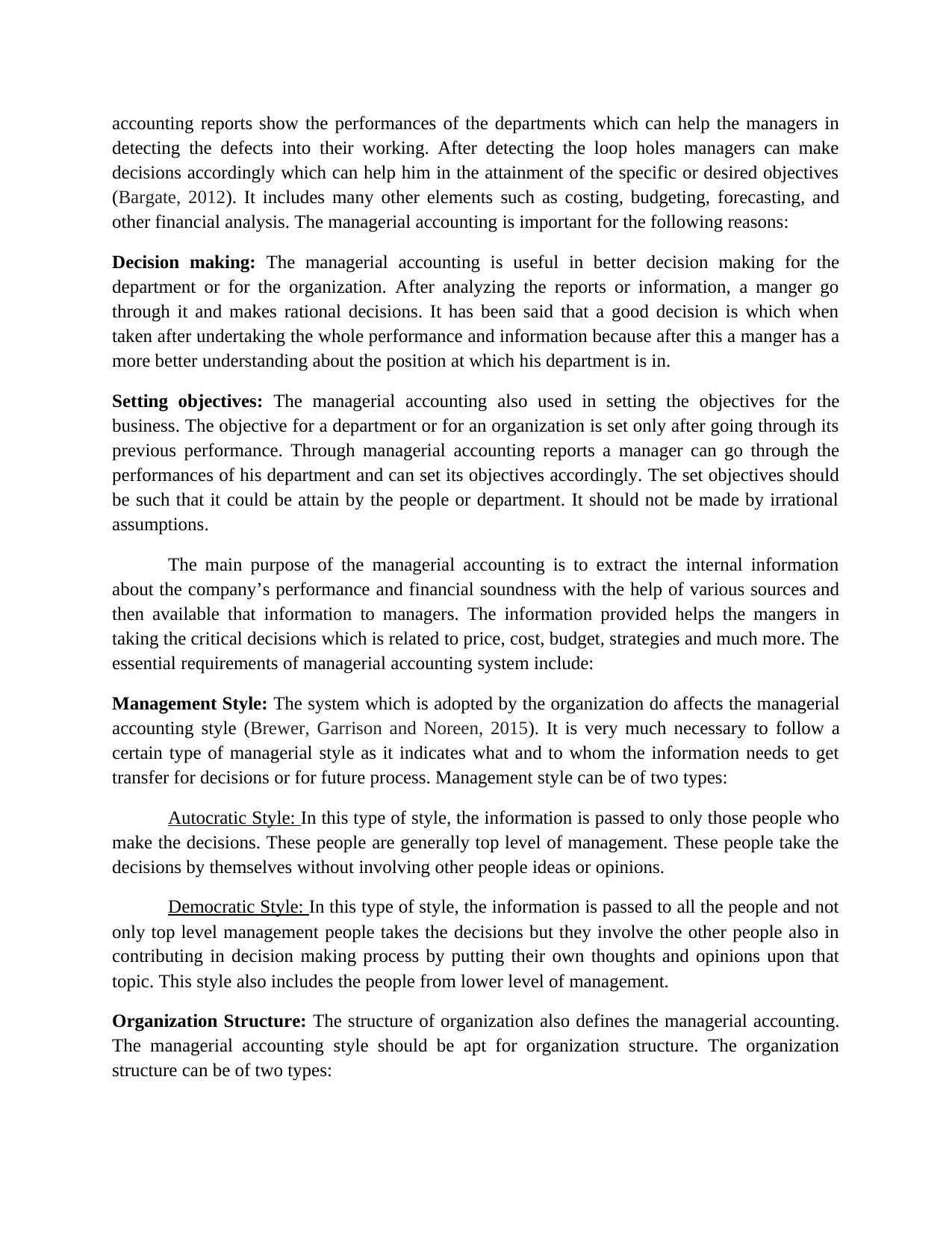
accounting reports show the performances of the departments which can help the managers in
detecting the defects into their working. After detecting the loop holes managers can make
decisions accordingly which can help him in the attainment of the specific or desired objectives
(Bargate, 2012). It includes many other elements such as costing, budgeting, forecasting, and
other financial analysis. The managerial accounting is important for the following reasons:
Decision making: The managerial accounting is useful in better decision making for the
department or for the organization. After analyzing the reports or information, a manger go
through it and makes rational decisions. It has been said that a good decision is which when
taken after undertaking the whole performance and information because after this a manger has a
more better understanding about the position at which his department is in.
Setting objectives: The managerial accounting also used in setting the objectives for the
business. The objective for a department or for an organization is set only after going through its
previous performance. Through managerial accounting reports a manager can go through the
performances of his department and can set its objectives accordingly. The set objectives should
be such that it could be attain by the people or department. It should not be made by irrational
assumptions.
The main purpose of the managerial accounting is to extract the internal information
about the company’s performance and financial soundness with the help of various sources and
then available that information to managers. The information provided helps the mangers in
taking the critical decisions which is related to price, cost, budget, strategies and much more. The
essential requirements of managerial accounting system include:
Management Style: The system which is adopted by the organization do affects the managerial
accounting style (Brewer, Garrison and Noreen, 2015). It is very much necessary to follow a
certain type of managerial style as it indicates what and to whom the information needs to get
transfer for decisions or for future process. Management style can be of two types:
Autocratic Style: In this type of style, the information is passed to only those people who
make the decisions. These people are generally top level of management. These people take the
decisions by themselves without involving other people ideas or opinions.
Democratic Style: In this type of style, the information is passed to all the people and not
only top level management people takes the decisions but they involve the other people also in
contributing in decision making process by putting their own thoughts and opinions upon that
topic. This style also includes the people from lower level of management.
Organization Structure: The structure of organization also defines the managerial accounting.
The managerial accounting style should be apt for organization structure. The organization
structure can be of two types:
detecting the defects into their working. After detecting the loop holes managers can make
decisions accordingly which can help him in the attainment of the specific or desired objectives
(Bargate, 2012). It includes many other elements such as costing, budgeting, forecasting, and
other financial analysis. The managerial accounting is important for the following reasons:
Decision making: The managerial accounting is useful in better decision making for the
department or for the organization. After analyzing the reports or information, a manger go
through it and makes rational decisions. It has been said that a good decision is which when
taken after undertaking the whole performance and information because after this a manger has a
more better understanding about the position at which his department is in.
Setting objectives: The managerial accounting also used in setting the objectives for the
business. The objective for a department or for an organization is set only after going through its
previous performance. Through managerial accounting reports a manager can go through the
performances of his department and can set its objectives accordingly. The set objectives should
be such that it could be attain by the people or department. It should not be made by irrational
assumptions.
The main purpose of the managerial accounting is to extract the internal information
about the company’s performance and financial soundness with the help of various sources and
then available that information to managers. The information provided helps the mangers in
taking the critical decisions which is related to price, cost, budget, strategies and much more. The
essential requirements of managerial accounting system include:
Management Style: The system which is adopted by the organization do affects the managerial
accounting style (Brewer, Garrison and Noreen, 2015). It is very much necessary to follow a
certain type of managerial style as it indicates what and to whom the information needs to get
transfer for decisions or for future process. Management style can be of two types:
Autocratic Style: In this type of style, the information is passed to only those people who
make the decisions. These people are generally top level of management. These people take the
decisions by themselves without involving other people ideas or opinions.
Democratic Style: In this type of style, the information is passed to all the people and not
only top level management people takes the decisions but they involve the other people also in
contributing in decision making process by putting their own thoughts and opinions upon that
topic. This style also includes the people from lower level of management.
Organization Structure: The structure of organization also defines the managerial accounting.
The managerial accounting style should be apt for organization structure. The organization
structure can be of two types:
Secure Best Marks with AI Grader
Need help grading? Try our AI Grader for instant feedback on your assignments.
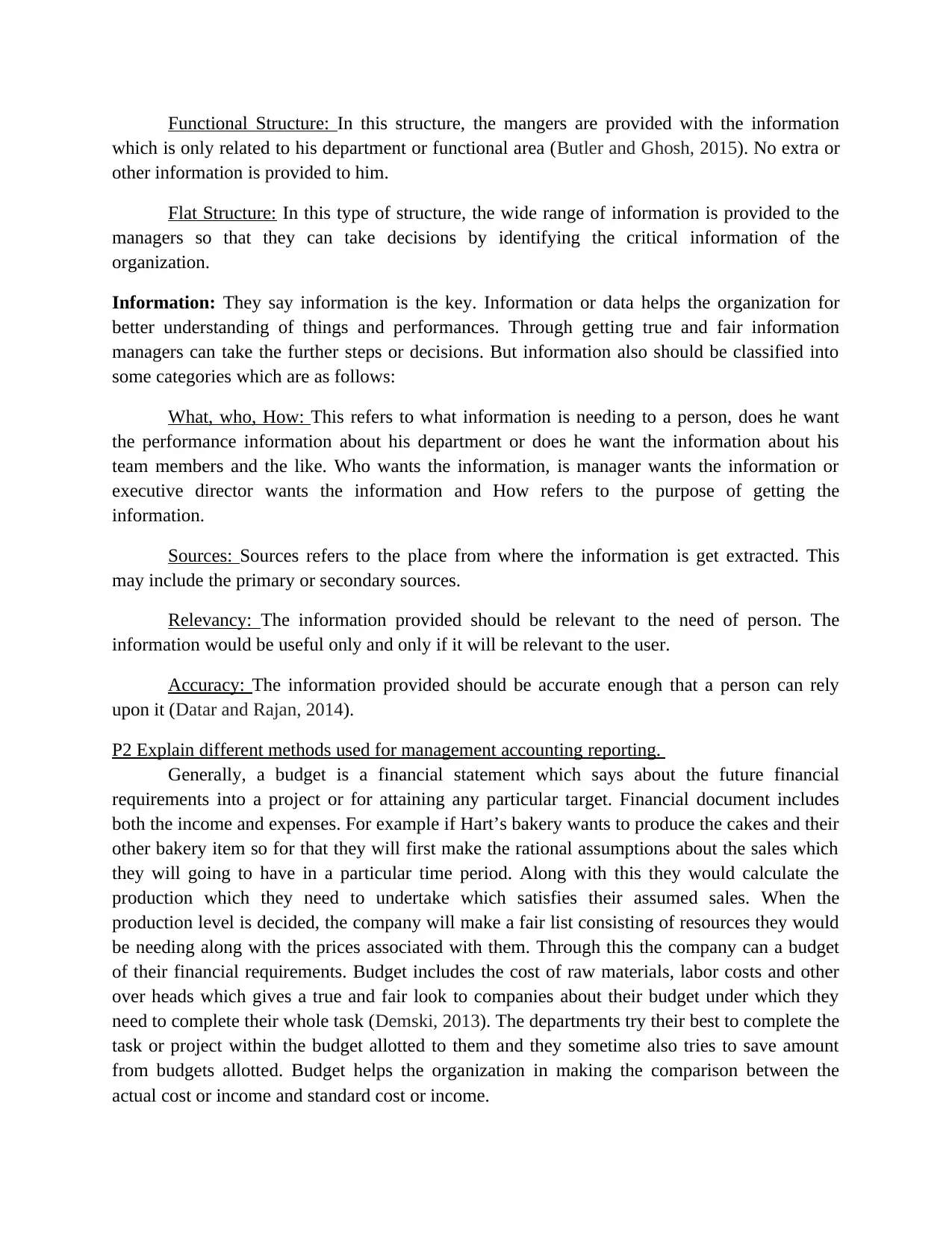
Functional Structure: In this structure, the mangers are provided with the information
which is only related to his department or functional area (Butler and Ghosh, 2015). No extra or
other information is provided to him.
Flat Structure: In this type of structure, the wide range of information is provided to the
managers so that they can take decisions by identifying the critical information of the
organization.
Information: They say information is the key. Information or data helps the organization for
better understanding of things and performances. Through getting true and fair information
managers can take the further steps or decisions. But information also should be classified into
some categories which are as follows:
What, who, How: This refers to what information is needing to a person, does he want
the performance information about his department or does he want the information about his
team members and the like. Who wants the information, is manager wants the information or
executive director wants the information and How refers to the purpose of getting the
information.
Sources: Sources refers to the place from where the information is get extracted. This
may include the primary or secondary sources.
Relevancy: The information provided should be relevant to the need of person. The
information would be useful only and only if it will be relevant to the user.
Accuracy: The information provided should be accurate enough that a person can rely
upon it (Datar and Rajan, 2014).
P2 Explain different methods used for management accounting reporting.
Generally, a budget is a financial statement which says about the future financial
requirements into a project or for attaining any particular target. Financial document includes
both the income and expenses. For example if Hart’s bakery wants to produce the cakes and their
other bakery item so for that they will first make the rational assumptions about the sales which
they will going to have in a particular time period. Along with this they would calculate the
production which they need to undertake which satisfies their assumed sales. When the
production level is decided, the company will make a fair list consisting of resources they would
be needing along with the prices associated with them. Through this the company can a budget
of their financial requirements. Budget includes the cost of raw materials, labor costs and other
over heads which gives a true and fair look to companies about their budget under which they
need to complete their whole task (Demski, 2013). The departments try their best to complete the
task or project within the budget allotted to them and they sometime also tries to save amount
from budgets allotted. Budget helps the organization in making the comparison between the
actual cost or income and standard cost or income.
which is only related to his department or functional area (Butler and Ghosh, 2015). No extra or
other information is provided to him.
Flat Structure: In this type of structure, the wide range of information is provided to the
managers so that they can take decisions by identifying the critical information of the
organization.
Information: They say information is the key. Information or data helps the organization for
better understanding of things and performances. Through getting true and fair information
managers can take the further steps or decisions. But information also should be classified into
some categories which are as follows:
What, who, How: This refers to what information is needing to a person, does he want
the performance information about his department or does he want the information about his
team members and the like. Who wants the information, is manager wants the information or
executive director wants the information and How refers to the purpose of getting the
information.
Sources: Sources refers to the place from where the information is get extracted. This
may include the primary or secondary sources.
Relevancy: The information provided should be relevant to the need of person. The
information would be useful only and only if it will be relevant to the user.
Accuracy: The information provided should be accurate enough that a person can rely
upon it (Datar and Rajan, 2014).
P2 Explain different methods used for management accounting reporting.
Generally, a budget is a financial statement which says about the future financial
requirements into a project or for attaining any particular target. Financial document includes
both the income and expenses. For example if Hart’s bakery wants to produce the cakes and their
other bakery item so for that they will first make the rational assumptions about the sales which
they will going to have in a particular time period. Along with this they would calculate the
production which they need to undertake which satisfies their assumed sales. When the
production level is decided, the company will make a fair list consisting of resources they would
be needing along with the prices associated with them. Through this the company can a budget
of their financial requirements. Budget includes the cost of raw materials, labor costs and other
over heads which gives a true and fair look to companies about their budget under which they
need to complete their whole task (Demski, 2013). The departments try their best to complete the
task or project within the budget allotted to them and they sometime also tries to save amount
from budgets allotted. Budget helps the organization in making the comparison between the
actual cost or income and standard cost or income.
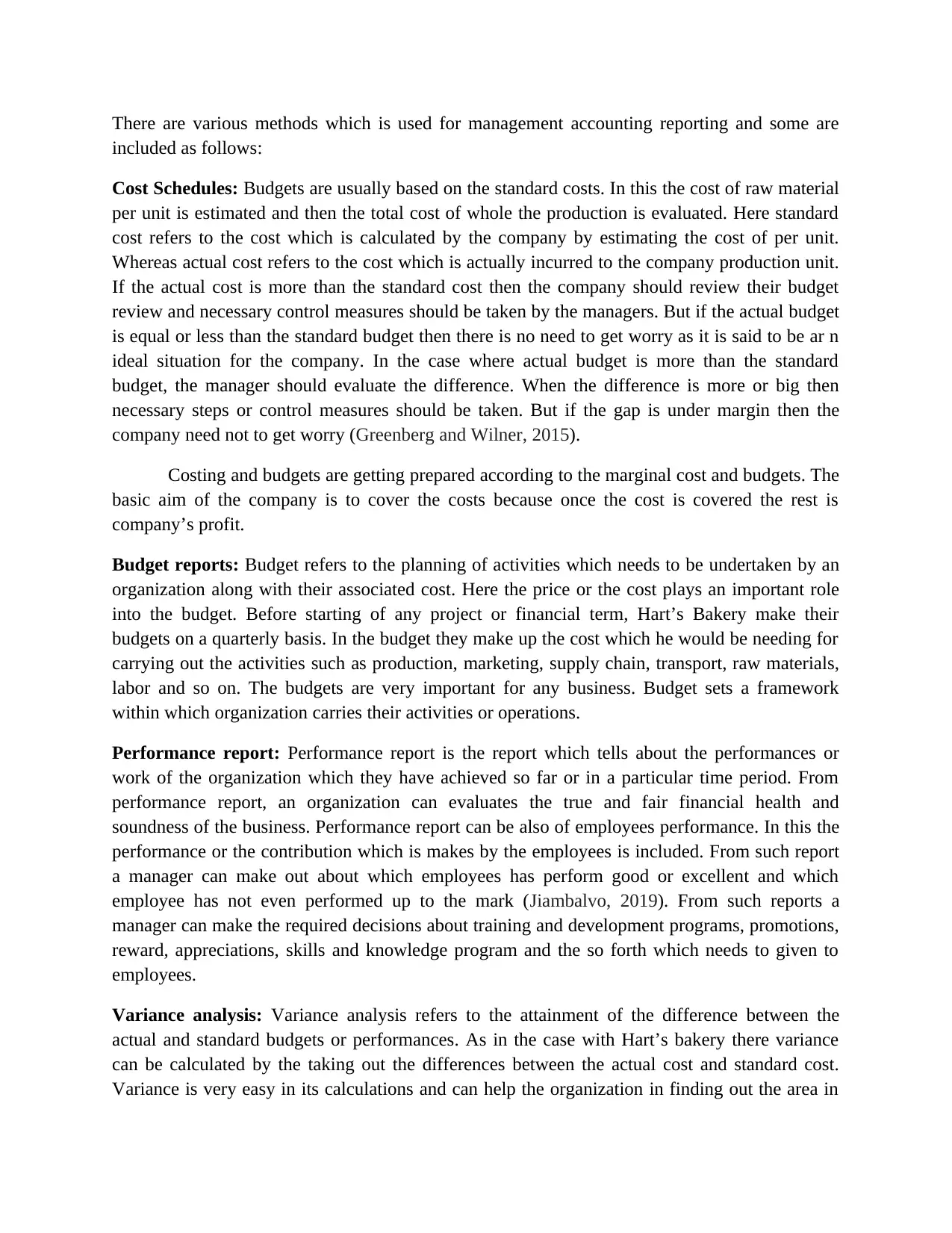
There are various methods which is used for management accounting reporting and some are
included as follows:
Cost Schedules: Budgets are usually based on the standard costs. In this the cost of raw material
per unit is estimated and then the total cost of whole the production is evaluated. Here standard
cost refers to the cost which is calculated by the company by estimating the cost of per unit.
Whereas actual cost refers to the cost which is actually incurred to the company production unit.
If the actual cost is more than the standard cost then the company should review their budget
review and necessary control measures should be taken by the managers. But if the actual budget
is equal or less than the standard budget then there is no need to get worry as it is said to be ar n
ideal situation for the company. In the case where actual budget is more than the standard
budget, the manager should evaluate the difference. When the difference is more or big then
necessary steps or control measures should be taken. But if the gap is under margin then the
company need not to get worry (Greenberg and Wilner, 2015).
Costing and budgets are getting prepared according to the marginal cost and budgets. The
basic aim of the company is to cover the costs because once the cost is covered the rest is
company’s profit.
Budget reports: Budget refers to the planning of activities which needs to be undertaken by an
organization along with their associated cost. Here the price or the cost plays an important role
into the budget. Before starting of any project or financial term, Hart’s Bakery make their
budgets on a quarterly basis. In the budget they make up the cost which he would be needing for
carrying out the activities such as production, marketing, supply chain, transport, raw materials,
labor and so on. The budgets are very important for any business. Budget sets a framework
within which organization carries their activities or operations.
Performance report: Performance report is the report which tells about the performances or
work of the organization which they have achieved so far or in a particular time period. From
performance report, an organization can evaluates the true and fair financial health and
soundness of the business. Performance report can be also of employees performance. In this the
performance or the contribution which is makes by the employees is included. From such report
a manager can make out about which employees has perform good or excellent and which
employee has not even performed up to the mark (Jiambalvo, 2019). From such reports a
manager can make the required decisions about training and development programs, promotions,
reward, appreciations, skills and knowledge program and the so forth which needs to given to
employees.
Variance analysis: Variance analysis refers to the attainment of the difference between the
actual and standard budgets or performances. As in the case with Hart’s bakery there variance
can be calculated by the taking out the differences between the actual cost and standard cost.
Variance is very easy in its calculations and can help the organization in finding out the area in
included as follows:
Cost Schedules: Budgets are usually based on the standard costs. In this the cost of raw material
per unit is estimated and then the total cost of whole the production is evaluated. Here standard
cost refers to the cost which is calculated by the company by estimating the cost of per unit.
Whereas actual cost refers to the cost which is actually incurred to the company production unit.
If the actual cost is more than the standard cost then the company should review their budget
review and necessary control measures should be taken by the managers. But if the actual budget
is equal or less than the standard budget then there is no need to get worry as it is said to be ar n
ideal situation for the company. In the case where actual budget is more than the standard
budget, the manager should evaluate the difference. When the difference is more or big then
necessary steps or control measures should be taken. But if the gap is under margin then the
company need not to get worry (Greenberg and Wilner, 2015).
Costing and budgets are getting prepared according to the marginal cost and budgets. The
basic aim of the company is to cover the costs because once the cost is covered the rest is
company’s profit.
Budget reports: Budget refers to the planning of activities which needs to be undertaken by an
organization along with their associated cost. Here the price or the cost plays an important role
into the budget. Before starting of any project or financial term, Hart’s Bakery make their
budgets on a quarterly basis. In the budget they make up the cost which he would be needing for
carrying out the activities such as production, marketing, supply chain, transport, raw materials,
labor and so on. The budgets are very important for any business. Budget sets a framework
within which organization carries their activities or operations.
Performance report: Performance report is the report which tells about the performances or
work of the organization which they have achieved so far or in a particular time period. From
performance report, an organization can evaluates the true and fair financial health and
soundness of the business. Performance report can be also of employees performance. In this the
performance or the contribution which is makes by the employees is included. From such report
a manager can make out about which employees has perform good or excellent and which
employee has not even performed up to the mark (Jiambalvo, 2019). From such reports a
manager can make the required decisions about training and development programs, promotions,
reward, appreciations, skills and knowledge program and the so forth which needs to given to
employees.
Variance analysis: Variance analysis refers to the attainment of the difference between the
actual and standard budgets or performances. As in the case with Hart’s bakery there variance
can be calculated by the taking out the differences between the actual cost and standard cost.
Variance is very easy in its calculations and can help the organization in finding out the area in
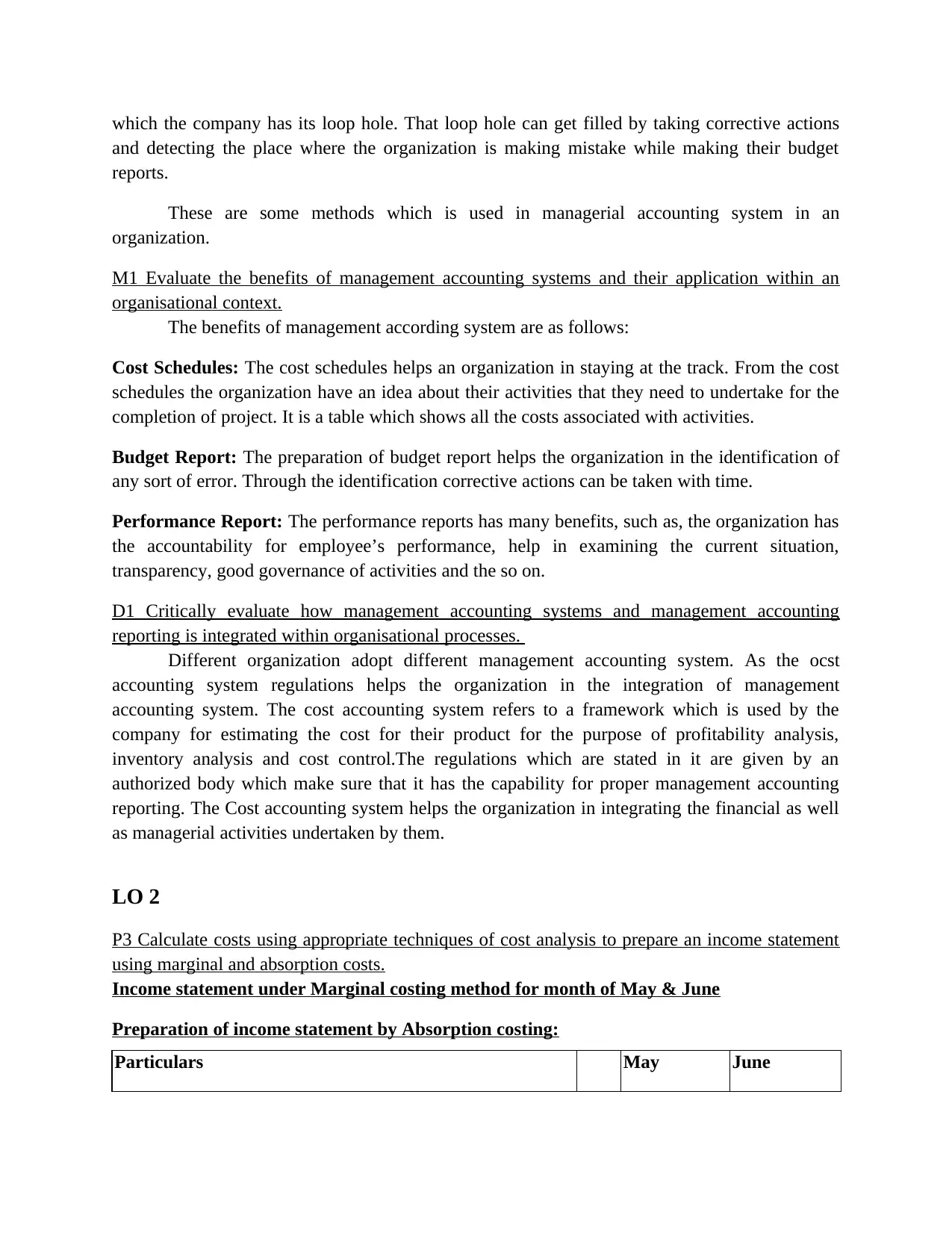
which the company has its loop hole. That loop hole can get filled by taking corrective actions
and detecting the place where the organization is making mistake while making their budget
reports.
These are some methods which is used in managerial accounting system in an
organization.
M1 Evaluate the benefits of management accounting systems and their application within an
organisational context.
The benefits of management according system are as follows:
Cost Schedules: The cost schedules helps an organization in staying at the track. From the cost
schedules the organization have an idea about their activities that they need to undertake for the
completion of project. It is a table which shows all the costs associated with activities.
Budget Report: The preparation of budget report helps the organization in the identification of
any sort of error. Through the identification corrective actions can be taken with time.
Performance Report: The performance reports has many benefits, such as, the organization has
the accountability for employee’s performance, help in examining the current situation,
transparency, good governance of activities and the so on.
D1 Critically evaluate how management accounting systems and management accounting
reporting is integrated within organisational processes.
Different organization adopt different management accounting system. As the ocst
accounting system regulations helps the organization in the integration of management
accounting system. The cost accounting system refers to a framework which is used by the
company for estimating the cost for their product for the purpose of profitability analysis,
inventory analysis and cost control.The regulations which are stated in it are given by an
authorized body which make sure that it has the capability for proper management accounting
reporting. The Cost accounting system helps the organization in integrating the financial as well
as managerial activities undertaken by them.
LO 2
P3 Calculate costs using appropriate techniques of cost analysis to prepare an income statement
using marginal and absorption costs.
Income statement under Marginal costing method for month of May & June
Preparation of income statement by Absorption costing:
Particulars May June
and detecting the place where the organization is making mistake while making their budget
reports.
These are some methods which is used in managerial accounting system in an
organization.
M1 Evaluate the benefits of management accounting systems and their application within an
organisational context.
The benefits of management according system are as follows:
Cost Schedules: The cost schedules helps an organization in staying at the track. From the cost
schedules the organization have an idea about their activities that they need to undertake for the
completion of project. It is a table which shows all the costs associated with activities.
Budget Report: The preparation of budget report helps the organization in the identification of
any sort of error. Through the identification corrective actions can be taken with time.
Performance Report: The performance reports has many benefits, such as, the organization has
the accountability for employee’s performance, help in examining the current situation,
transparency, good governance of activities and the so on.
D1 Critically evaluate how management accounting systems and management accounting
reporting is integrated within organisational processes.
Different organization adopt different management accounting system. As the ocst
accounting system regulations helps the organization in the integration of management
accounting system. The cost accounting system refers to a framework which is used by the
company for estimating the cost for their product for the purpose of profitability analysis,
inventory analysis and cost control.The regulations which are stated in it are given by an
authorized body which make sure that it has the capability for proper management accounting
reporting. The Cost accounting system helps the organization in integrating the financial as well
as managerial activities undertaken by them.
LO 2
P3 Calculate costs using appropriate techniques of cost analysis to prepare an income statement
using marginal and absorption costs.
Income statement under Marginal costing method for month of May & June
Preparation of income statement by Absorption costing:
Particulars May June
Paraphrase This Document
Need a fresh take? Get an instant paraphrase of this document with our AI Paraphraser
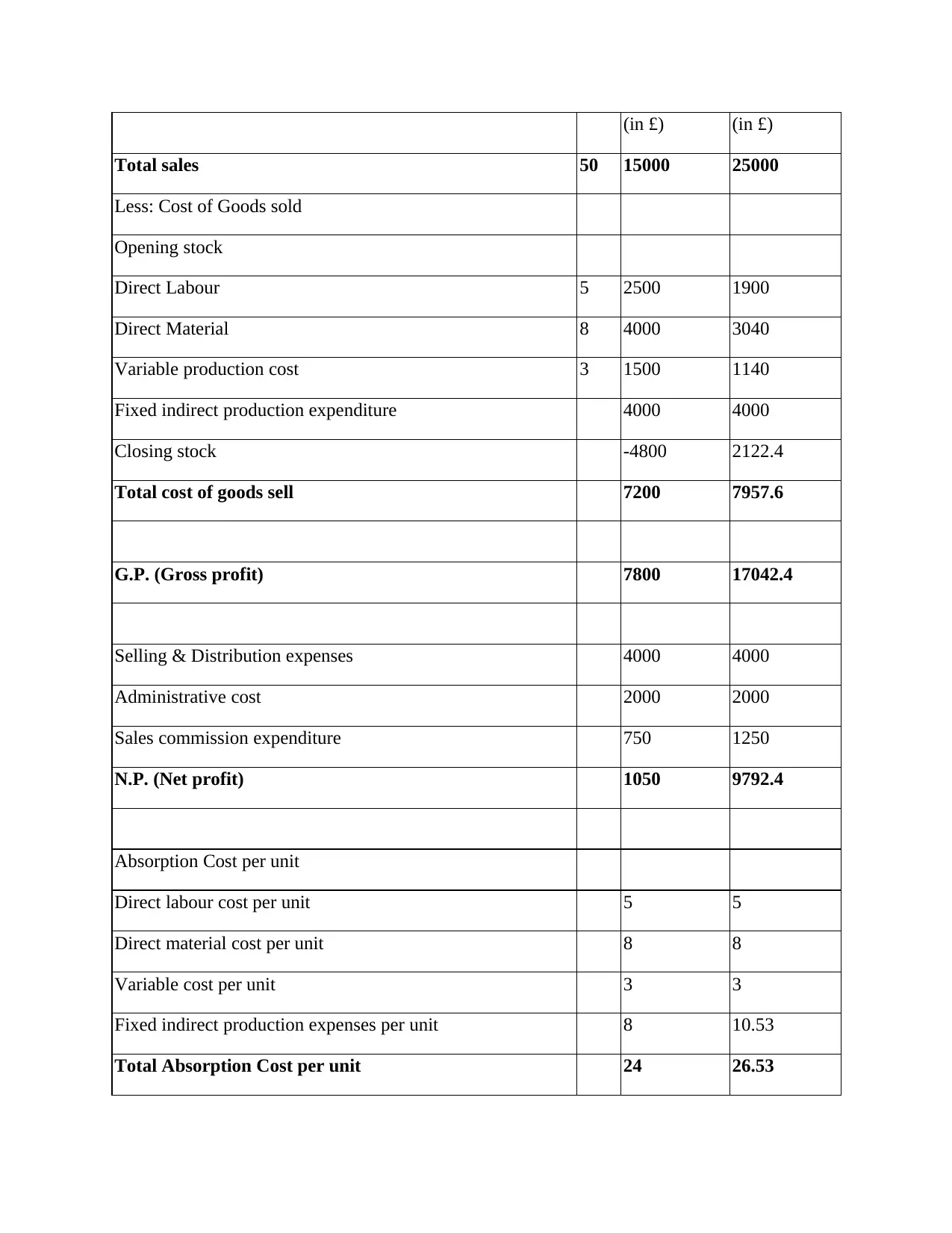
(in £) (in £)
Total sales 50 15000 25000
Less: Cost of Goods sold
Opening stock
Direct Labour 5 2500 1900
Direct Material 8 4000 3040
Variable production cost 3 1500 1140
Fixed indirect production expenditure 4000 4000
Closing stock -4800 2122.4
Total cost of goods sell 7200 7957.6
G.P. (Gross profit) 7800 17042.4
Selling & Distribution expenses 4000 4000
Administrative cost 2000 2000
Sales commission expenditure 750 1250
N.P. (Net profit) 1050 9792.4
Absorption Cost per unit
Direct labour cost per unit 5 5
Direct material cost per unit 8 8
Variable cost per unit 3 3
Fixed indirect production expenses per unit 8 10.53
Total Absorption Cost per unit 24 26.53
Total sales 50 15000 25000
Less: Cost of Goods sold
Opening stock
Direct Labour 5 2500 1900
Direct Material 8 4000 3040
Variable production cost 3 1500 1140
Fixed indirect production expenditure 4000 4000
Closing stock -4800 2122.4
Total cost of goods sell 7200 7957.6
G.P. (Gross profit) 7800 17042.4
Selling & Distribution expenses 4000 4000
Administrative cost 2000 2000
Sales commission expenditure 750 1250
N.P. (Net profit) 1050 9792.4
Absorption Cost per unit
Direct labour cost per unit 5 5
Direct material cost per unit 8 8
Variable cost per unit 3 3
Fixed indirect production expenses per unit 8 10.53
Total Absorption Cost per unit 24 26.53
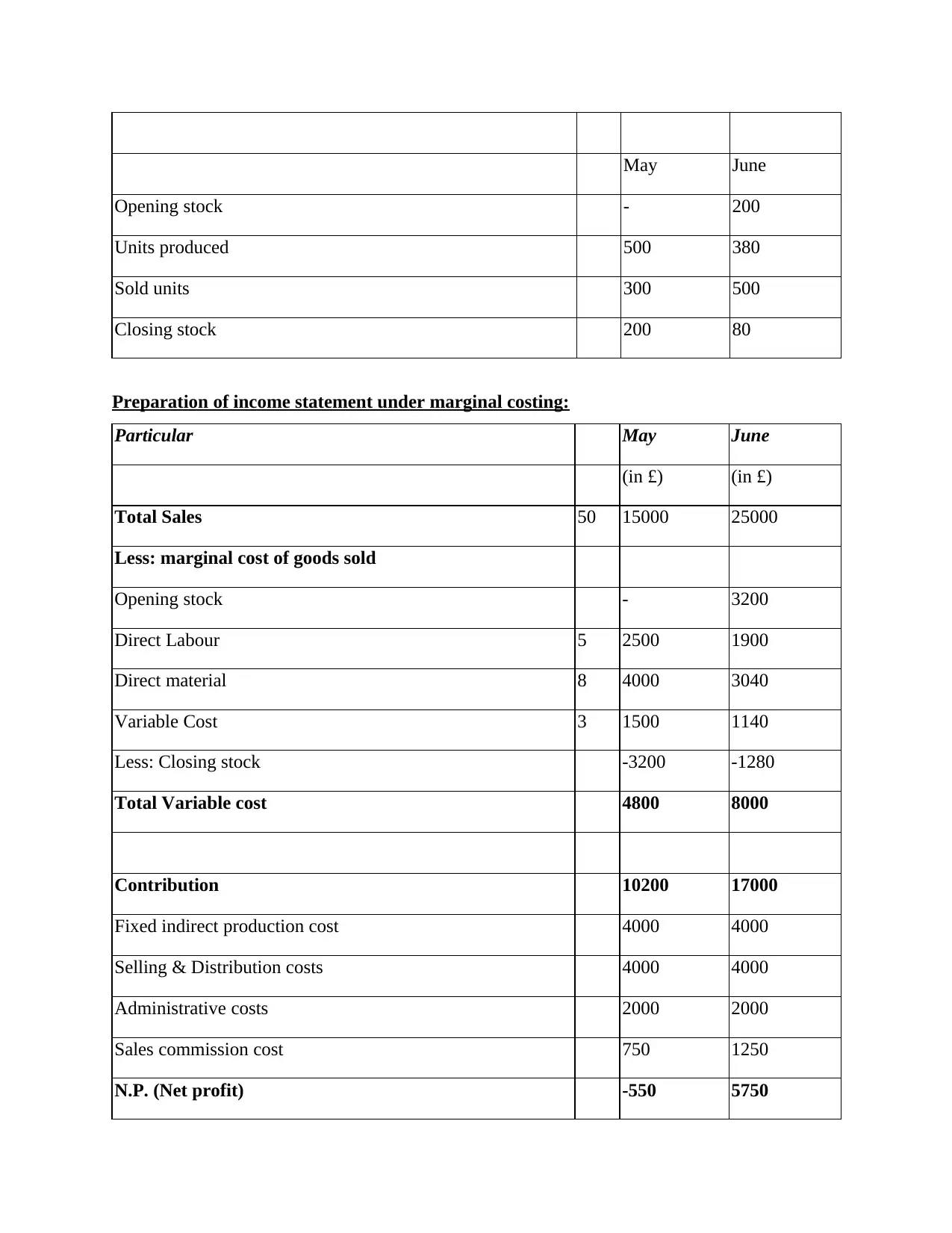
May June
Opening stock - 200
Units produced 500 380
Sold units 300 500
Closing stock 200 80
Preparation of income statement under marginal costing:
Particular May June
(in £) (in £)
Total Sales 50 15000 25000
Less: marginal cost of goods sold
Opening stock - 3200
Direct Labour 5 2500 1900
Direct material 8 4000 3040
Variable Cost 3 1500 1140
Less: Closing stock -3200 -1280
Total Variable cost 4800 8000
Contribution 10200 17000
Fixed indirect production cost 4000 4000
Selling & Distribution costs 4000 4000
Administrative costs 2000 2000
Sales commission cost 750 1250
N.P. (Net profit) -550 5750
Opening stock - 200
Units produced 500 380
Sold units 300 500
Closing stock 200 80
Preparation of income statement under marginal costing:
Particular May June
(in £) (in £)
Total Sales 50 15000 25000
Less: marginal cost of goods sold
Opening stock - 3200
Direct Labour 5 2500 1900
Direct material 8 4000 3040
Variable Cost 3 1500 1140
Less: Closing stock -3200 -1280
Total Variable cost 4800 8000
Contribution 10200 17000
Fixed indirect production cost 4000 4000
Selling & Distribution costs 4000 4000
Administrative costs 2000 2000
Sales commission cost 750 1250
N.P. (Net profit) -550 5750
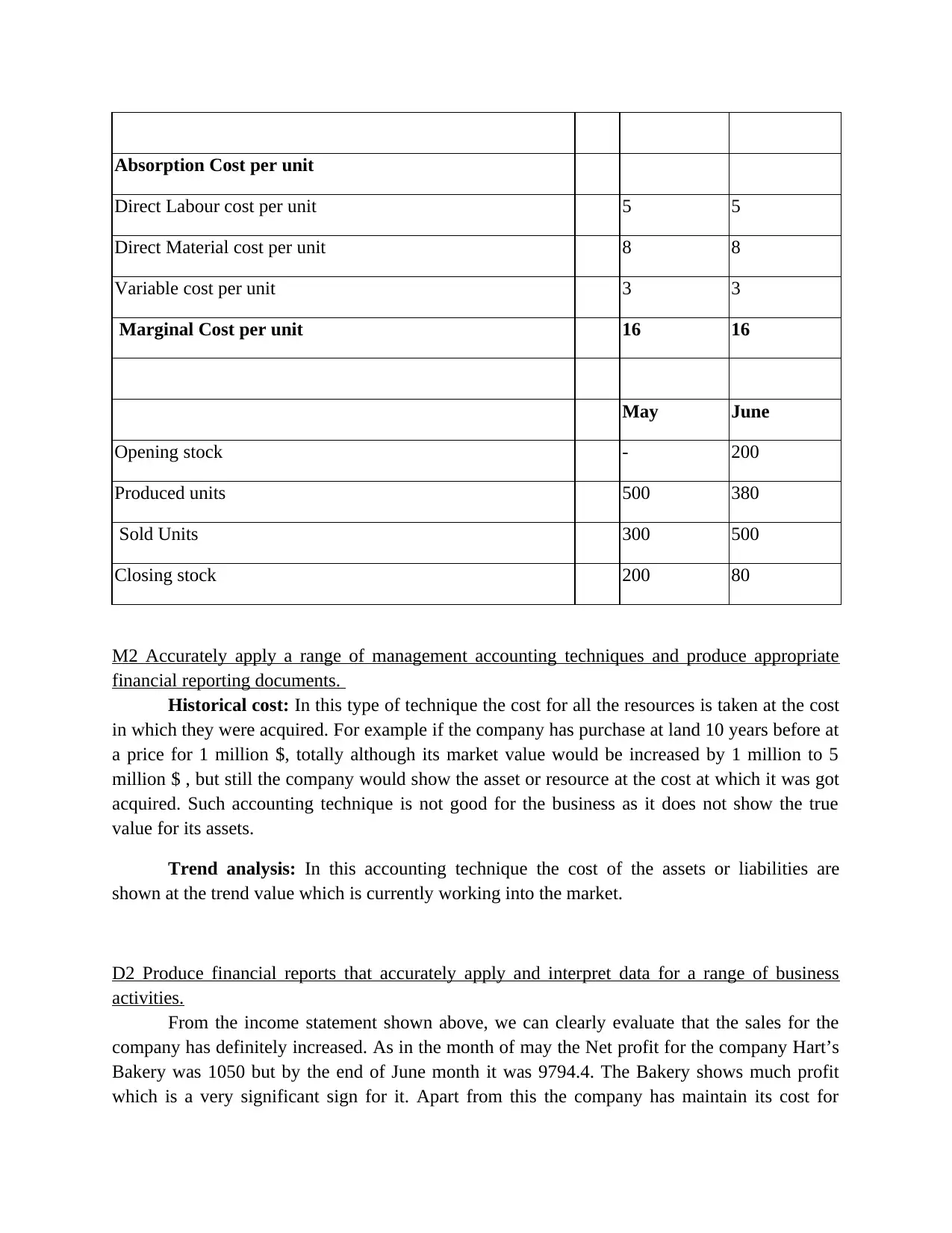
Absorption Cost per unit
Direct Labour cost per unit 5 5
Direct Material cost per unit 8 8
Variable cost per unit 3 3
Marginal Cost per unit 16 16
May June
Opening stock - 200
Produced units 500 380
Sold Units 300 500
Closing stock 200 80
M2 Accurately apply a range of management accounting techniques and produce appropriate
financial reporting documents.
Historical cost: In this type of technique the cost for all the resources is taken at the cost
in which they were acquired. For example if the company has purchase at land 10 years before at
a price for 1 million $, totally although its market value would be increased by 1 million to 5
million $ , but still the company would show the asset or resource at the cost at which it was got
acquired. Such accounting technique is not good for the business as it does not show the true
value for its assets.
Trend analysis: In this accounting technique the cost of the assets or liabilities are
shown at the trend value which is currently working into the market.
D2 Produce financial reports that accurately apply and interpret data for a range of business
activities.
From the income statement shown above, we can clearly evaluate that the sales for the
company has definitely increased. As in the month of may the Net profit for the company Hart’s
Bakery was 1050 but by the end of June month it was 9794.4. The Bakery shows much profit
which is a very significant sign for it. Apart from this the company has maintain its cost for
Direct Labour cost per unit 5 5
Direct Material cost per unit 8 8
Variable cost per unit 3 3
Marginal Cost per unit 16 16
May June
Opening stock - 200
Produced units 500 380
Sold Units 300 500
Closing stock 200 80
M2 Accurately apply a range of management accounting techniques and produce appropriate
financial reporting documents.
Historical cost: In this type of technique the cost for all the resources is taken at the cost
in which they were acquired. For example if the company has purchase at land 10 years before at
a price for 1 million $, totally although its market value would be increased by 1 million to 5
million $ , but still the company would show the asset or resource at the cost at which it was got
acquired. Such accounting technique is not good for the business as it does not show the true
value for its assets.
Trend analysis: In this accounting technique the cost of the assets or liabilities are
shown at the trend value which is currently working into the market.
D2 Produce financial reports that accurately apply and interpret data for a range of business
activities.
From the income statement shown above, we can clearly evaluate that the sales for the
company has definitely increased. As in the month of may the Net profit for the company Hart’s
Bakery was 1050 but by the end of June month it was 9794.4. The Bakery shows much profit
which is a very significant sign for it. Apart from this the company has maintain its cost for
Secure Best Marks with AI Grader
Need help grading? Try our AI Grader for instant feedback on your assignments.
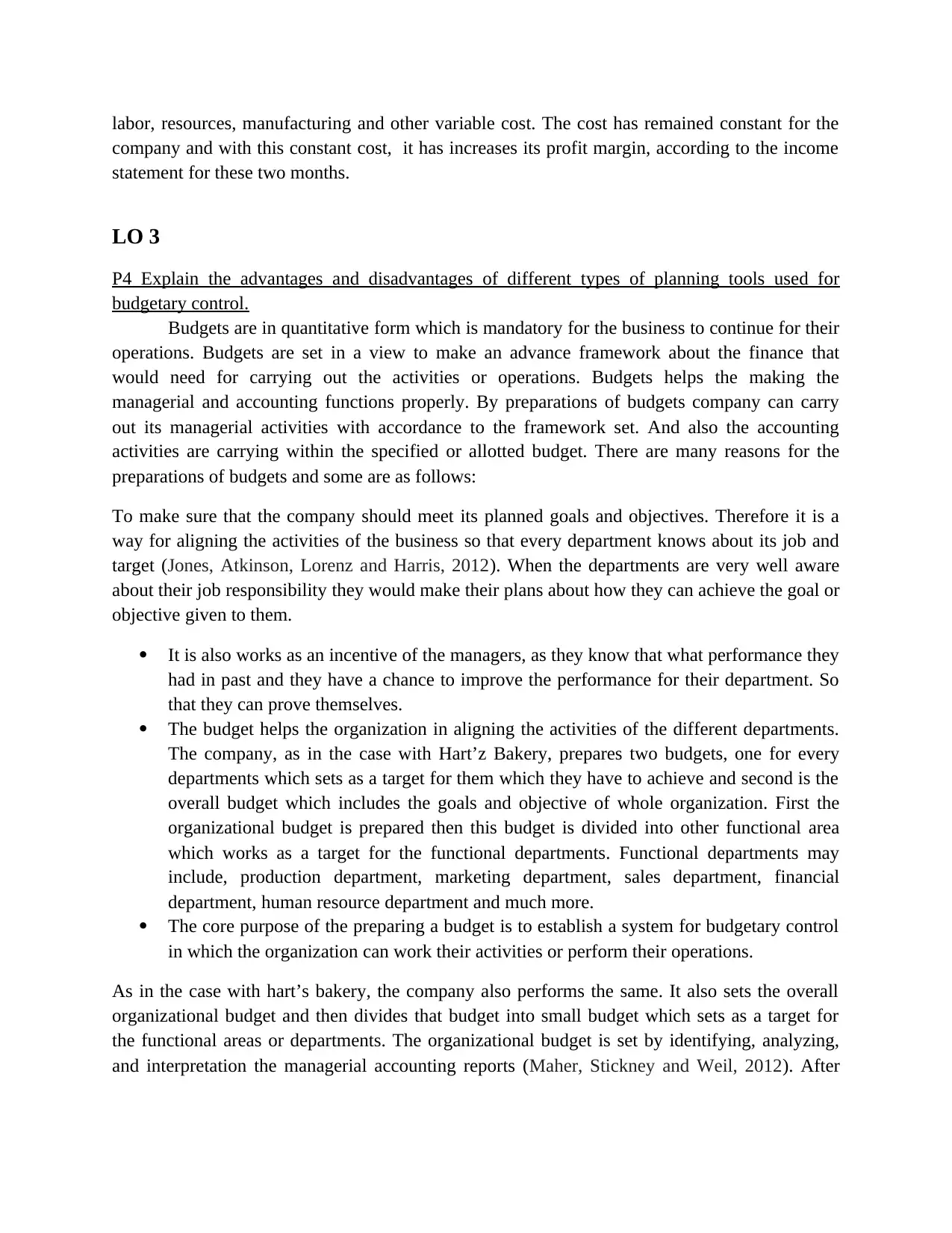
labor, resources, manufacturing and other variable cost. The cost has remained constant for the
company and with this constant cost, it has increases its profit margin, according to the income
statement for these two months.
LO 3
P4 Explain the advantages and disadvantages of different types of planning tools used for
budgetary control.
Budgets are in quantitative form which is mandatory for the business to continue for their
operations. Budgets are set in a view to make an advance framework about the finance that
would need for carrying out the activities or operations. Budgets helps the making the
managerial and accounting functions properly. By preparations of budgets company can carry
out its managerial activities with accordance to the framework set. And also the accounting
activities are carrying within the specified or allotted budget. There are many reasons for the
preparations of budgets and some are as follows:
To make sure that the company should meet its planned goals and objectives. Therefore it is a
way for aligning the activities of the business so that every department knows about its job and
target (Jones, Atkinson, Lorenz and Harris, 2012). When the departments are very well aware
about their job responsibility they would make their plans about how they can achieve the goal or
objective given to them.
It is also works as an incentive of the managers, as they know that what performance they
had in past and they have a chance to improve the performance for their department. So
that they can prove themselves.
The budget helps the organization in aligning the activities of the different departments.
The company, as in the case with Hart’z Bakery, prepares two budgets, one for every
departments which sets as a target for them which they have to achieve and second is the
overall budget which includes the goals and objective of whole organization. First the
organizational budget is prepared then this budget is divided into other functional area
which works as a target for the functional departments. Functional departments may
include, production department, marketing department, sales department, financial
department, human resource department and much more.
The core purpose of the preparing a budget is to establish a system for budgetary control
in which the organization can work their activities or perform their operations.
As in the case with hart’s bakery, the company also performs the same. It also sets the overall
organizational budget and then divides that budget into small budget which sets as a target for
the functional areas or departments. The organizational budget is set by identifying, analyzing,
and interpretation the managerial accounting reports (Maher, Stickney and Weil, 2012). After
company and with this constant cost, it has increases its profit margin, according to the income
statement for these two months.
LO 3
P4 Explain the advantages and disadvantages of different types of planning tools used for
budgetary control.
Budgets are in quantitative form which is mandatory for the business to continue for their
operations. Budgets are set in a view to make an advance framework about the finance that
would need for carrying out the activities or operations. Budgets helps the making the
managerial and accounting functions properly. By preparations of budgets company can carry
out its managerial activities with accordance to the framework set. And also the accounting
activities are carrying within the specified or allotted budget. There are many reasons for the
preparations of budgets and some are as follows:
To make sure that the company should meet its planned goals and objectives. Therefore it is a
way for aligning the activities of the business so that every department knows about its job and
target (Jones, Atkinson, Lorenz and Harris, 2012). When the departments are very well aware
about their job responsibility they would make their plans about how they can achieve the goal or
objective given to them.
It is also works as an incentive of the managers, as they know that what performance they
had in past and they have a chance to improve the performance for their department. So
that they can prove themselves.
The budget helps the organization in aligning the activities of the different departments.
The company, as in the case with Hart’z Bakery, prepares two budgets, one for every
departments which sets as a target for them which they have to achieve and second is the
overall budget which includes the goals and objective of whole organization. First the
organizational budget is prepared then this budget is divided into other functional area
which works as a target for the functional departments. Functional departments may
include, production department, marketing department, sales department, financial
department, human resource department and much more.
The core purpose of the preparing a budget is to establish a system for budgetary control
in which the organization can work their activities or perform their operations.
As in the case with hart’s bakery, the company also performs the same. It also sets the overall
organizational budget and then divides that budget into small budget which sets as a target for
the functional areas or departments. The organizational budget is set by identifying, analyzing,
and interpretation the managerial accounting reports (Maher, Stickney and Weil, 2012). After
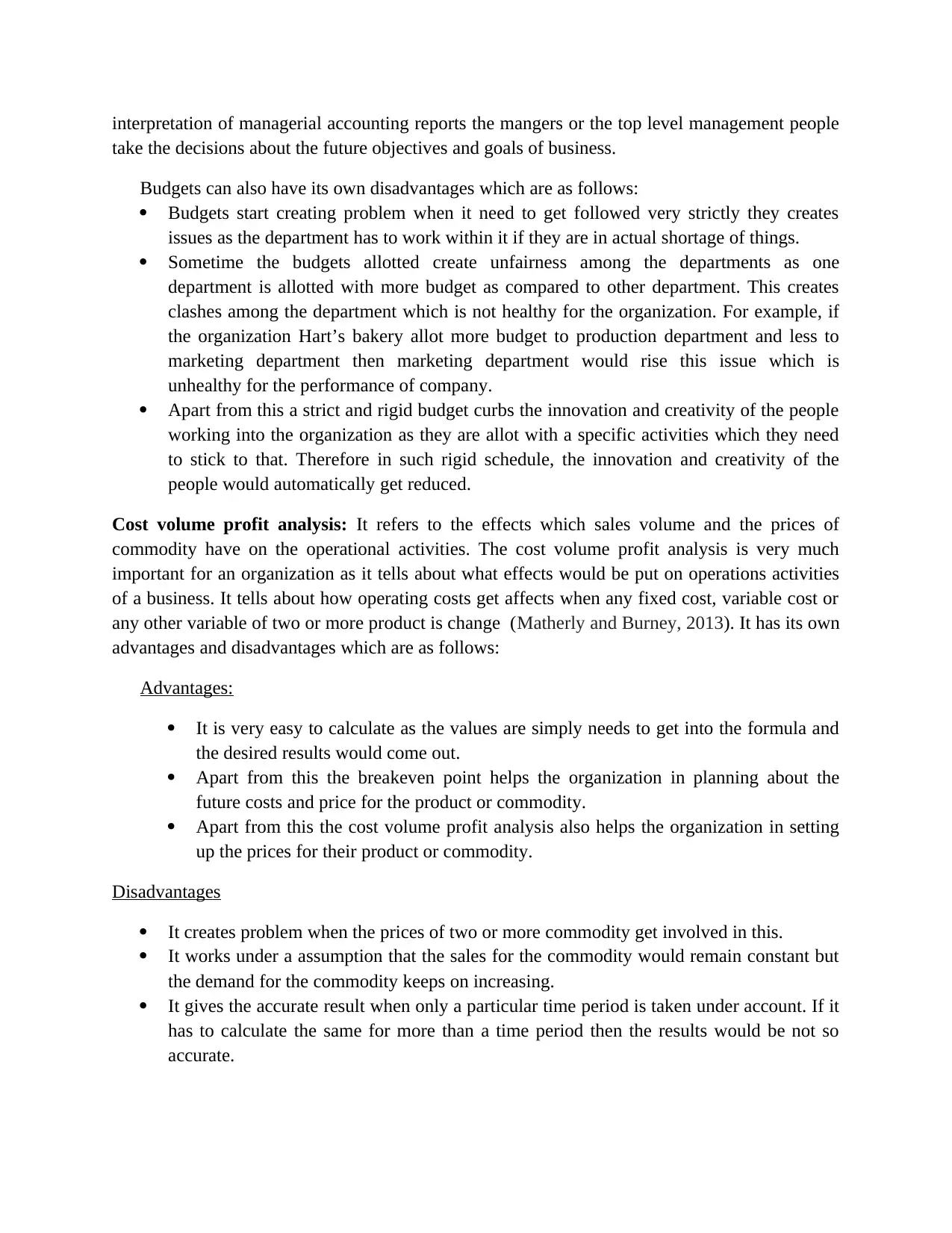
interpretation of managerial accounting reports the mangers or the top level management people
take the decisions about the future objectives and goals of business.
Budgets can also have its own disadvantages which are as follows:
Budgets start creating problem when it need to get followed very strictly they creates
issues as the department has to work within it if they are in actual shortage of things.
Sometime the budgets allotted create unfairness among the departments as one
department is allotted with more budget as compared to other department. This creates
clashes among the department which is not healthy for the organization. For example, if
the organization Hart’s bakery allot more budget to production department and less to
marketing department then marketing department would rise this issue which is
unhealthy for the performance of company.
Apart from this a strict and rigid budget curbs the innovation and creativity of the people
working into the organization as they are allot with a specific activities which they need
to stick to that. Therefore in such rigid schedule, the innovation and creativity of the
people would automatically get reduced.
Cost volume profit analysis: It refers to the effects which sales volume and the prices of
commodity have on the operational activities. The cost volume profit analysis is very much
important for an organization as it tells about what effects would be put on operations activities
of a business. It tells about how operating costs get affects when any fixed cost, variable cost or
any other variable of two or more product is change (Matherly and Burney, 2013). It has its own
advantages and disadvantages which are as follows:
Advantages:
It is very easy to calculate as the values are simply needs to get into the formula and
the desired results would come out.
Apart from this the breakeven point helps the organization in planning about the
future costs and price for the product or commodity.
Apart from this the cost volume profit analysis also helps the organization in setting
up the prices for their product or commodity.
Disadvantages
It creates problem when the prices of two or more commodity get involved in this.
It works under a assumption that the sales for the commodity would remain constant but
the demand for the commodity keeps on increasing.
It gives the accurate result when only a particular time period is taken under account. If it
has to calculate the same for more than a time period then the results would be not so
accurate.
take the decisions about the future objectives and goals of business.
Budgets can also have its own disadvantages which are as follows:
Budgets start creating problem when it need to get followed very strictly they creates
issues as the department has to work within it if they are in actual shortage of things.
Sometime the budgets allotted create unfairness among the departments as one
department is allotted with more budget as compared to other department. This creates
clashes among the department which is not healthy for the organization. For example, if
the organization Hart’s bakery allot more budget to production department and less to
marketing department then marketing department would rise this issue which is
unhealthy for the performance of company.
Apart from this a strict and rigid budget curbs the innovation and creativity of the people
working into the organization as they are allot with a specific activities which they need
to stick to that. Therefore in such rigid schedule, the innovation and creativity of the
people would automatically get reduced.
Cost volume profit analysis: It refers to the effects which sales volume and the prices of
commodity have on the operational activities. The cost volume profit analysis is very much
important for an organization as it tells about what effects would be put on operations activities
of a business. It tells about how operating costs get affects when any fixed cost, variable cost or
any other variable of two or more product is change (Matherly and Burney, 2013). It has its own
advantages and disadvantages which are as follows:
Advantages:
It is very easy to calculate as the values are simply needs to get into the formula and
the desired results would come out.
Apart from this the breakeven point helps the organization in planning about the
future costs and price for the product or commodity.
Apart from this the cost volume profit analysis also helps the organization in setting
up the prices for their product or commodity.
Disadvantages
It creates problem when the prices of two or more commodity get involved in this.
It works under a assumption that the sales for the commodity would remain constant but
the demand for the commodity keeps on increasing.
It gives the accurate result when only a particular time period is taken under account. If it
has to calculate the same for more than a time period then the results would be not so
accurate.
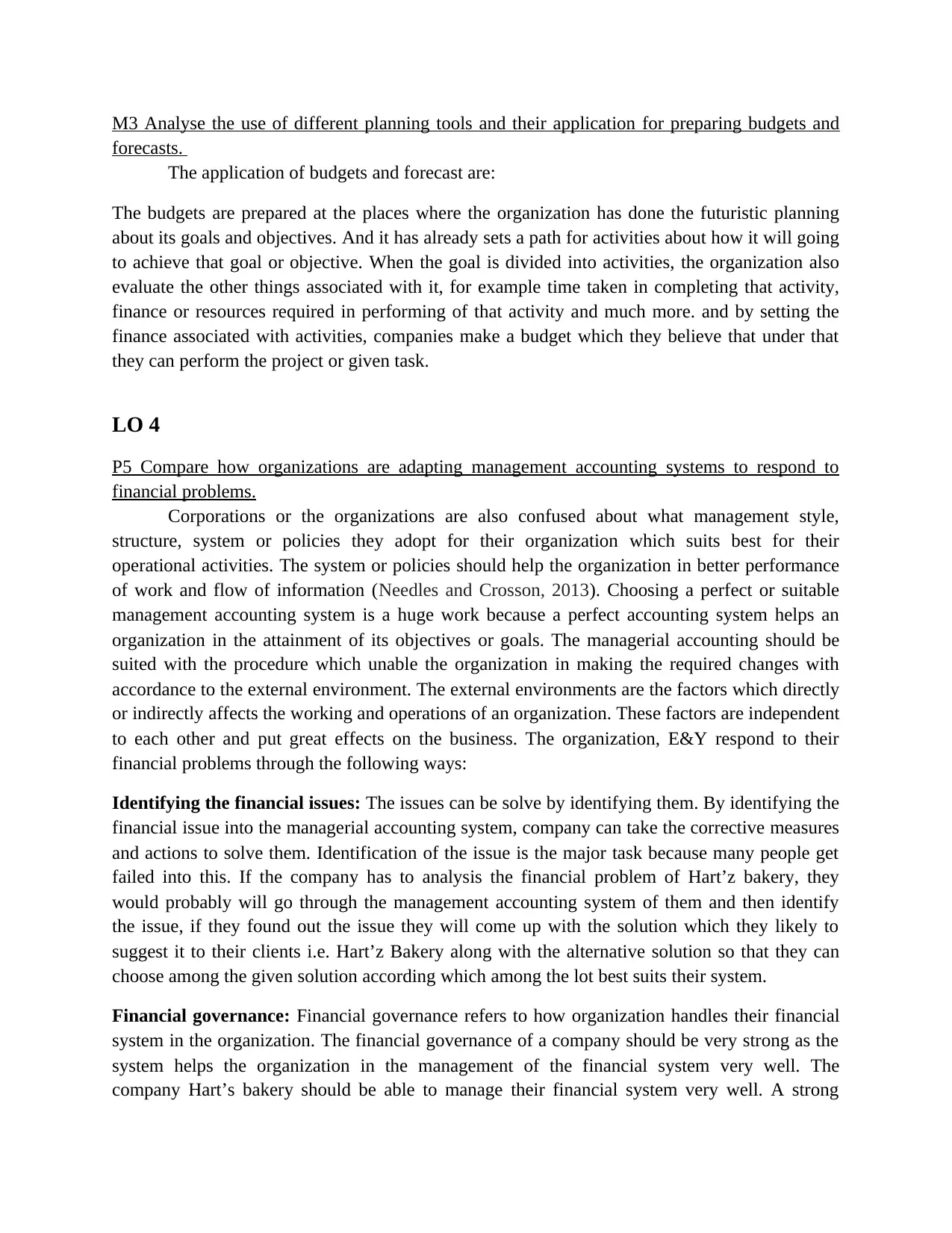
M3 Analyse the use of different planning tools and their application for preparing budgets and
forecasts.
The application of budgets and forecast are:
The budgets are prepared at the places where the organization has done the futuristic planning
about its goals and objectives. And it has already sets a path for activities about how it will going
to achieve that goal or objective. When the goal is divided into activities, the organization also
evaluate the other things associated with it, for example time taken in completing that activity,
finance or resources required in performing of that activity and much more. and by setting the
finance associated with activities, companies make a budget which they believe that under that
they can perform the project or given task.
LO 4
P5 Compare how organizations are adapting management accounting systems to respond to
financial problems.
Corporations or the organizations are also confused about what management style,
structure, system or policies they adopt for their organization which suits best for their
operational activities. The system or policies should help the organization in better performance
of work and flow of information (Needles and Crosson, 2013). Choosing a perfect or suitable
management accounting system is a huge work because a perfect accounting system helps an
organization in the attainment of its objectives or goals. The managerial accounting should be
suited with the procedure which unable the organization in making the required changes with
accordance to the external environment. The external environments are the factors which directly
or indirectly affects the working and operations of an organization. These factors are independent
to each other and put great effects on the business. The organization, E&Y respond to their
financial problems through the following ways:
Identifying the financial issues: The issues can be solve by identifying them. By identifying the
financial issue into the managerial accounting system, company can take the corrective measures
and actions to solve them. Identification of the issue is the major task because many people get
failed into this. If the company has to analysis the financial problem of Hart’z bakery, they
would probably will go through the management accounting system of them and then identify
the issue, if they found out the issue they will come up with the solution which they likely to
suggest it to their clients i.e. Hart’z Bakery along with the alternative solution so that they can
choose among the given solution according which among the lot best suits their system.
Financial governance: Financial governance refers to how organization handles their financial
system in the organization. The financial governance of a company should be very strong as the
system helps the organization in the management of the financial system very well. The
company Hart’s bakery should be able to manage their financial system very well. A strong
forecasts.
The application of budgets and forecast are:
The budgets are prepared at the places where the organization has done the futuristic planning
about its goals and objectives. And it has already sets a path for activities about how it will going
to achieve that goal or objective. When the goal is divided into activities, the organization also
evaluate the other things associated with it, for example time taken in completing that activity,
finance or resources required in performing of that activity and much more. and by setting the
finance associated with activities, companies make a budget which they believe that under that
they can perform the project or given task.
LO 4
P5 Compare how organizations are adapting management accounting systems to respond to
financial problems.
Corporations or the organizations are also confused about what management style,
structure, system or policies they adopt for their organization which suits best for their
operational activities. The system or policies should help the organization in better performance
of work and flow of information (Needles and Crosson, 2013). Choosing a perfect or suitable
management accounting system is a huge work because a perfect accounting system helps an
organization in the attainment of its objectives or goals. The managerial accounting should be
suited with the procedure which unable the organization in making the required changes with
accordance to the external environment. The external environments are the factors which directly
or indirectly affects the working and operations of an organization. These factors are independent
to each other and put great effects on the business. The organization, E&Y respond to their
financial problems through the following ways:
Identifying the financial issues: The issues can be solve by identifying them. By identifying the
financial issue into the managerial accounting system, company can take the corrective measures
and actions to solve them. Identification of the issue is the major task because many people get
failed into this. If the company has to analysis the financial problem of Hart’z bakery, they
would probably will go through the management accounting system of them and then identify
the issue, if they found out the issue they will come up with the solution which they likely to
suggest it to their clients i.e. Hart’z Bakery along with the alternative solution so that they can
choose among the given solution according which among the lot best suits their system.
Financial governance: Financial governance refers to how organization handles their financial
system in the organization. The financial governance of a company should be very strong as the
system helps the organization in the management of the financial system very well. The
company Hart’s bakery should be able to manage their financial system very well. A strong
Paraphrase This Document
Need a fresh take? Get an instant paraphrase of this document with our AI Paraphraser
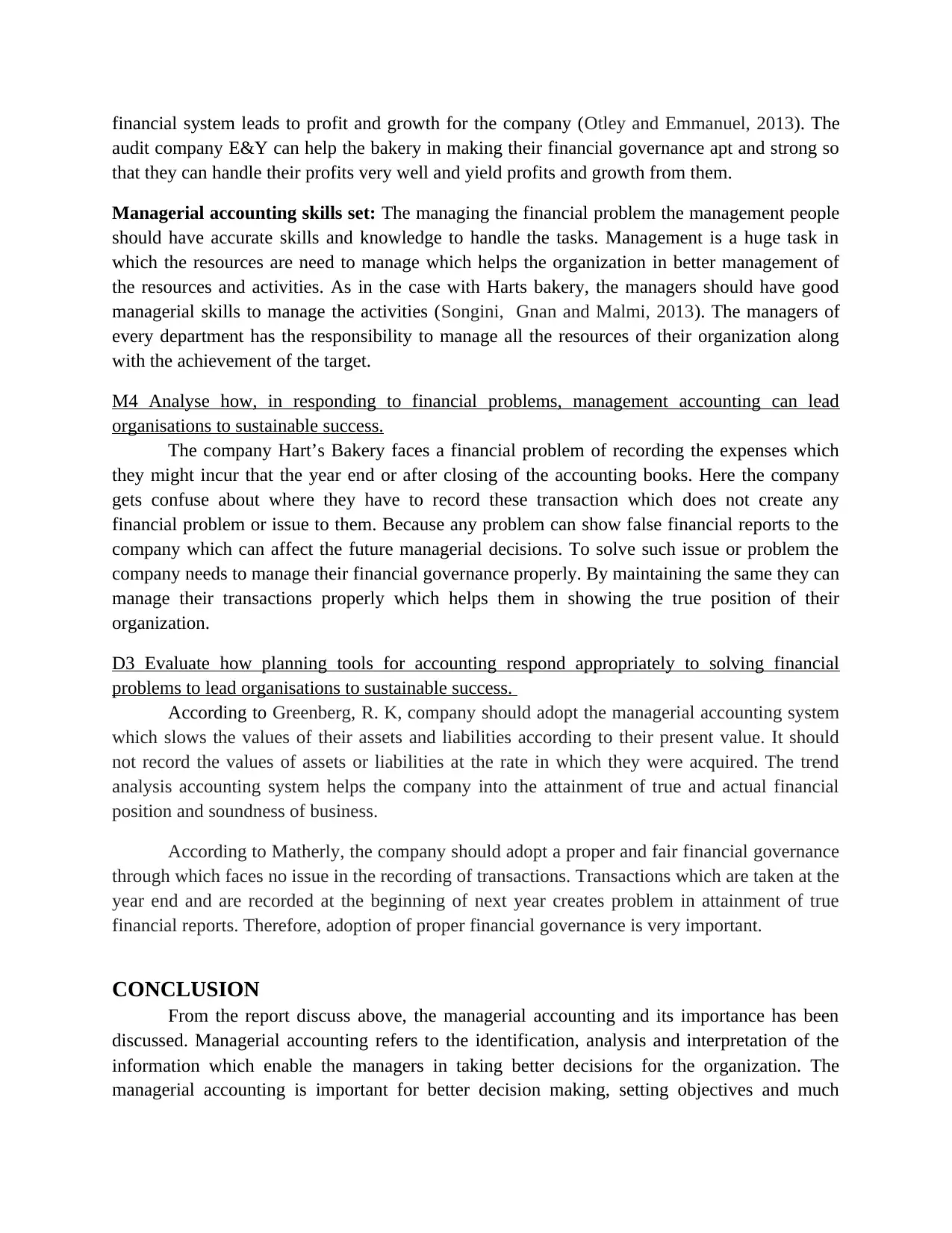
financial system leads to profit and growth for the company (Otley and Emmanuel, 2013). The
audit company E&Y can help the bakery in making their financial governance apt and strong so
that they can handle their profits very well and yield profits and growth from them.
Managerial accounting skills set: The managing the financial problem the management people
should have accurate skills and knowledge to handle the tasks. Management is a huge task in
which the resources are need to manage which helps the organization in better management of
the resources and activities. As in the case with Harts bakery, the managers should have good
managerial skills to manage the activities (Songini, Gnan and Malmi, 2013). The managers of
every department has the responsibility to manage all the resources of their organization along
with the achievement of the target.
M4 Analyse how, in responding to financial problems, management accounting can lead
organisations to sustainable success.
The company Hart’s Bakery faces a financial problem of recording the expenses which
they might incur that the year end or after closing of the accounting books. Here the company
gets confuse about where they have to record these transaction which does not create any
financial problem or issue to them. Because any problem can show false financial reports to the
company which can affect the future managerial decisions. To solve such issue or problem the
company needs to manage their financial governance properly. By maintaining the same they can
manage their transactions properly which helps them in showing the true position of their
organization.
D3 Evaluate how planning tools for accounting respond appropriately to solving financial
problems to lead organisations to sustainable success.
According to Greenberg, R. K, company should adopt the managerial accounting system
which slows the values of their assets and liabilities according to their present value. It should
not record the values of assets or liabilities at the rate in which they were acquired. The trend
analysis accounting system helps the company into the attainment of true and actual financial
position and soundness of business.
According to Matherly, the company should adopt a proper and fair financial governance
through which faces no issue in the recording of transactions. Transactions which are taken at the
year end and are recorded at the beginning of next year creates problem in attainment of true
financial reports. Therefore, adoption of proper financial governance is very important.
CONCLUSION
From the report discuss above, the managerial accounting and its importance has been
discussed. Managerial accounting refers to the identification, analysis and interpretation of the
information which enable the managers in taking better decisions for the organization. The
managerial accounting is important for better decision making, setting objectives and much
audit company E&Y can help the bakery in making their financial governance apt and strong so
that they can handle their profits very well and yield profits and growth from them.
Managerial accounting skills set: The managing the financial problem the management people
should have accurate skills and knowledge to handle the tasks. Management is a huge task in
which the resources are need to manage which helps the organization in better management of
the resources and activities. As in the case with Harts bakery, the managers should have good
managerial skills to manage the activities (Songini, Gnan and Malmi, 2013). The managers of
every department has the responsibility to manage all the resources of their organization along
with the achievement of the target.
M4 Analyse how, in responding to financial problems, management accounting can lead
organisations to sustainable success.
The company Hart’s Bakery faces a financial problem of recording the expenses which
they might incur that the year end or after closing of the accounting books. Here the company
gets confuse about where they have to record these transaction which does not create any
financial problem or issue to them. Because any problem can show false financial reports to the
company which can affect the future managerial decisions. To solve such issue or problem the
company needs to manage their financial governance properly. By maintaining the same they can
manage their transactions properly which helps them in showing the true position of their
organization.
D3 Evaluate how planning tools for accounting respond appropriately to solving financial
problems to lead organisations to sustainable success.
According to Greenberg, R. K, company should adopt the managerial accounting system
which slows the values of their assets and liabilities according to their present value. It should
not record the values of assets or liabilities at the rate in which they were acquired. The trend
analysis accounting system helps the company into the attainment of true and actual financial
position and soundness of business.
According to Matherly, the company should adopt a proper and fair financial governance
through which faces no issue in the recording of transactions. Transactions which are taken at the
year end and are recorded at the beginning of next year creates problem in attainment of true
financial reports. Therefore, adoption of proper financial governance is very important.
CONCLUSION
From the report discuss above, the managerial accounting and its importance has been
discussed. Managerial accounting refers to the identification, analysis and interpretation of the
information which enable the managers in taking better decisions for the organization. The
managerial accounting is important for better decision making, setting objectives and much
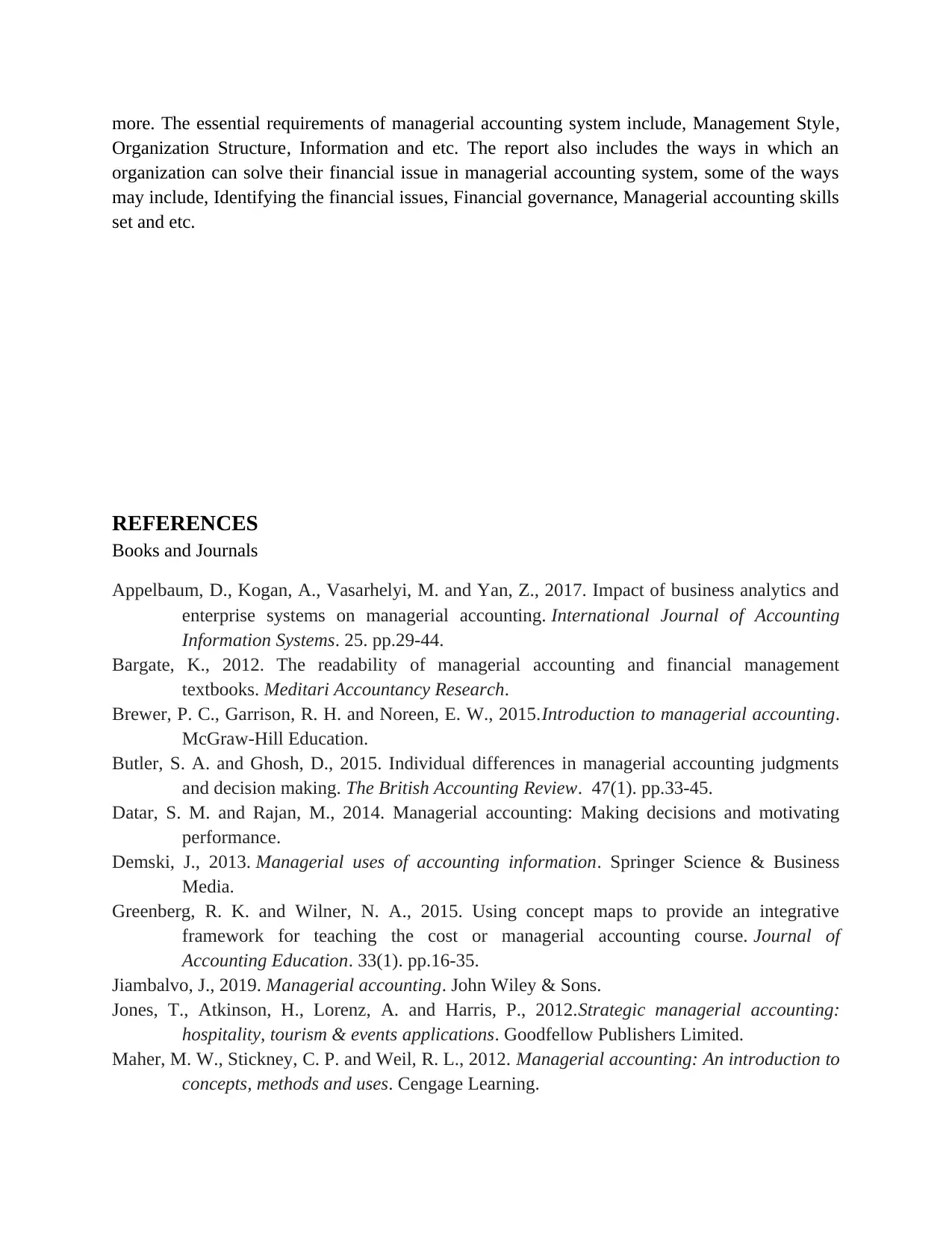
more. The essential requirements of managerial accounting system include, Management Style,
Organization Structure, Information and etc. The report also includes the ways in which an
organization can solve their financial issue in managerial accounting system, some of the ways
may include, Identifying the financial issues, Financial governance, Managerial accounting skills
set and etc.
REFERENCES
Books and Journals
Appelbaum, D., Kogan, A., Vasarhelyi, M. and Yan, Z., 2017. Impact of business analytics and
enterprise systems on managerial accounting. International Journal of Accounting
Information Systems. 25. pp.29-44.
Bargate, K., 2012. The readability of managerial accounting and financial management
textbooks. Meditari Accountancy Research.
Brewer, P. C., Garrison, R. H. and Noreen, E. W., 2015.Introduction to managerial accounting.
McGraw-Hill Education.
Butler, S. A. and Ghosh, D., 2015. Individual differences in managerial accounting judgments
and decision making. The British Accounting Review. 47(1). pp.33-45.
Datar, S. M. and Rajan, M., 2014. Managerial accounting: Making decisions and motivating
performance.
Demski, J., 2013. Managerial uses of accounting information. Springer Science & Business
Media.
Greenberg, R. K. and Wilner, N. A., 2015. Using concept maps to provide an integrative
framework for teaching the cost or managerial accounting course. Journal of
Accounting Education. 33(1). pp.16-35.
Jiambalvo, J., 2019. Managerial accounting. John Wiley & Sons.
Jones, T., Atkinson, H., Lorenz, A. and Harris, P., 2012.Strategic managerial accounting:
hospitality, tourism & events applications. Goodfellow Publishers Limited.
Maher, M. W., Stickney, C. P. and Weil, R. L., 2012. Managerial accounting: An introduction to
concepts, methods and uses. Cengage Learning.
Organization Structure, Information and etc. The report also includes the ways in which an
organization can solve their financial issue in managerial accounting system, some of the ways
may include, Identifying the financial issues, Financial governance, Managerial accounting skills
set and etc.
REFERENCES
Books and Journals
Appelbaum, D., Kogan, A., Vasarhelyi, M. and Yan, Z., 2017. Impact of business analytics and
enterprise systems on managerial accounting. International Journal of Accounting
Information Systems. 25. pp.29-44.
Bargate, K., 2012. The readability of managerial accounting and financial management
textbooks. Meditari Accountancy Research.
Brewer, P. C., Garrison, R. H. and Noreen, E. W., 2015.Introduction to managerial accounting.
McGraw-Hill Education.
Butler, S. A. and Ghosh, D., 2015. Individual differences in managerial accounting judgments
and decision making. The British Accounting Review. 47(1). pp.33-45.
Datar, S. M. and Rajan, M., 2014. Managerial accounting: Making decisions and motivating
performance.
Demski, J., 2013. Managerial uses of accounting information. Springer Science & Business
Media.
Greenberg, R. K. and Wilner, N. A., 2015. Using concept maps to provide an integrative
framework for teaching the cost or managerial accounting course. Journal of
Accounting Education. 33(1). pp.16-35.
Jiambalvo, J., 2019. Managerial accounting. John Wiley & Sons.
Jones, T., Atkinson, H., Lorenz, A. and Harris, P., 2012.Strategic managerial accounting:
hospitality, tourism & events applications. Goodfellow Publishers Limited.
Maher, M. W., Stickney, C. P. and Weil, R. L., 2012. Managerial accounting: An introduction to
concepts, methods and uses. Cengage Learning.
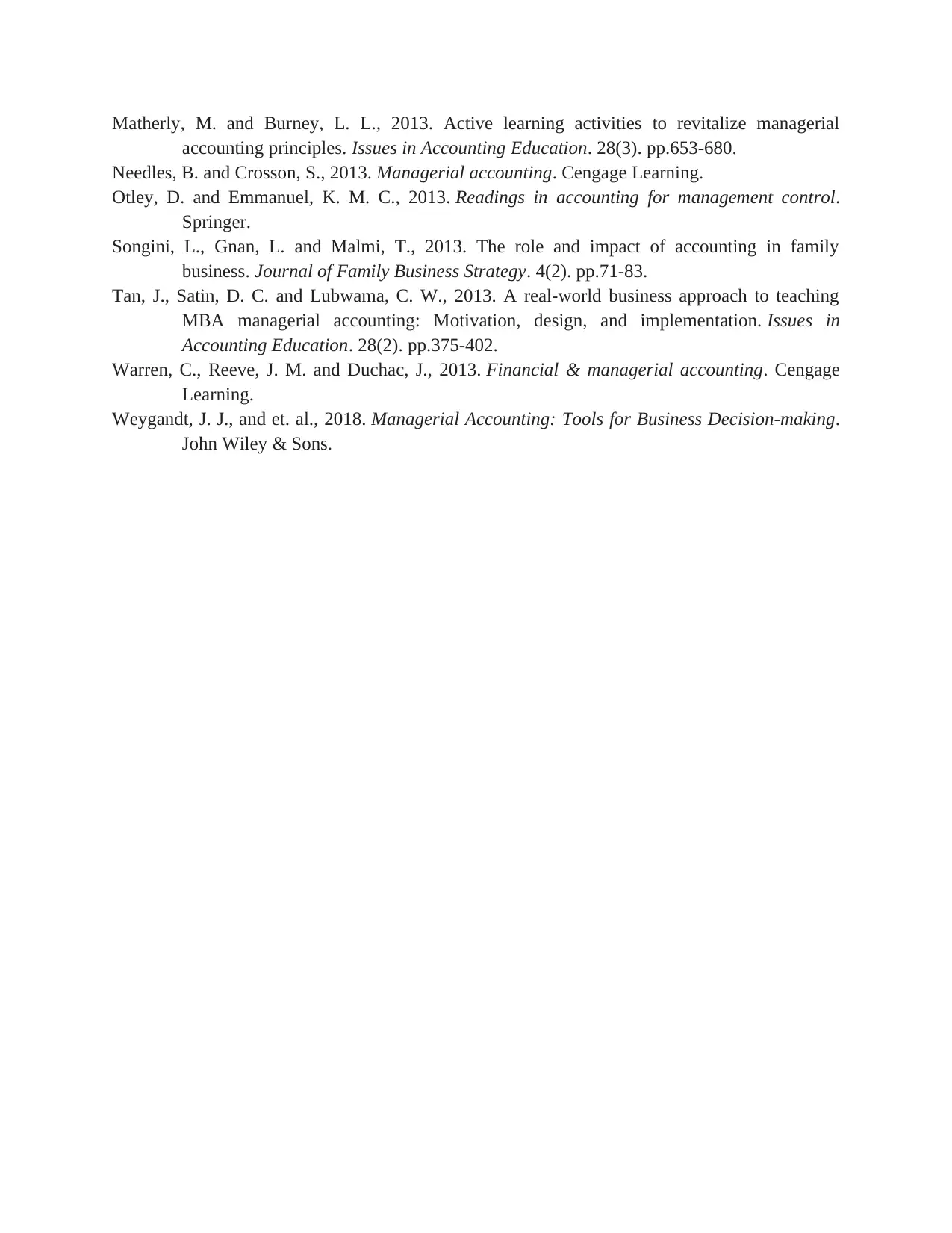
Matherly, M. and Burney, L. L., 2013. Active learning activities to revitalize managerial
accounting principles. Issues in Accounting Education. 28(3). pp.653-680.
Needles, B. and Crosson, S., 2013. Managerial accounting. Cengage Learning.
Otley, D. and Emmanuel, K. M. C., 2013. Readings in accounting for management control.
Springer.
Songini, L., Gnan, L. and Malmi, T., 2013. The role and impact of accounting in family
business. Journal of Family Business Strategy. 4(2). pp.71-83.
Tan, J., Satin, D. C. and Lubwama, C. W., 2013. A real-world business approach to teaching
MBA managerial accounting: Motivation, design, and implementation. Issues in
Accounting Education. 28(2). pp.375-402.
Warren, C., Reeve, J. M. and Duchac, J., 2013. Financial & managerial accounting. Cengage
Learning.
Weygandt, J. J., and et. al., 2018. Managerial Accounting: Tools for Business Decision-making.
John Wiley & Sons.
accounting principles. Issues in Accounting Education. 28(3). pp.653-680.
Needles, B. and Crosson, S., 2013. Managerial accounting. Cengage Learning.
Otley, D. and Emmanuel, K. M. C., 2013. Readings in accounting for management control.
Springer.
Songini, L., Gnan, L. and Malmi, T., 2013. The role and impact of accounting in family
business. Journal of Family Business Strategy. 4(2). pp.71-83.
Tan, J., Satin, D. C. and Lubwama, C. W., 2013. A real-world business approach to teaching
MBA managerial accounting: Motivation, design, and implementation. Issues in
Accounting Education. 28(2). pp.375-402.
Warren, C., Reeve, J. M. and Duchac, J., 2013. Financial & managerial accounting. Cengage
Learning.
Weygandt, J. J., and et. al., 2018. Managerial Accounting: Tools for Business Decision-making.
John Wiley & Sons.
1 out of 16
Related Documents
Your All-in-One AI-Powered Toolkit for Academic Success.
+13062052269
info@desklib.com
Available 24*7 on WhatsApp / Email
![[object Object]](/_next/static/media/star-bottom.7253800d.svg)
Unlock your academic potential
© 2024 | Zucol Services PVT LTD | All rights reserved.





